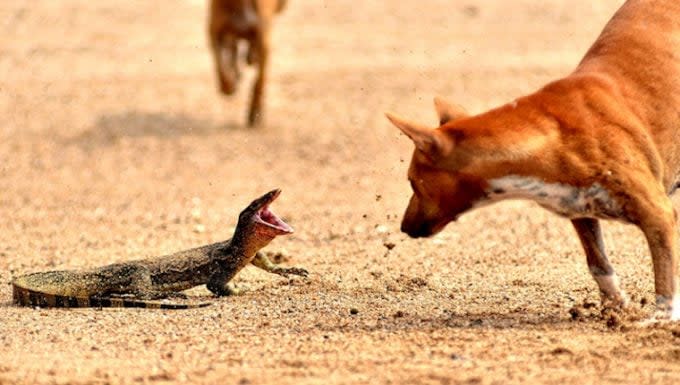Lizard Venom Poisoning in Dogs: Symptoms, Causes, & Treatments

(Learn more about lizard venom poisoning in dogs. Picture credit: Alexander Dasril / EyeEm / Getty Images)
Lizard venom poisoning in dogs happens when a dog is bitten by a lizard. The severity of the condition depends on how long a dog is bitten for.
Specifically, the Mexican Beaded lizard and Gila Monster lizard are a danger to dogs. Usually, these lizards are found in the southwest of America.
If you see the signs of the condition in your dog, then get to a veterinarian for a proper diagnosis and treatment.
Here’s what you should know about the symptoms, causes, and treatments for the condition.
Symptoms of Lizard Venom Poisoning in Dogs
The condition produces a range of symptoms. For instance, some of the most common symptoms include:
Salivation
Bleeding
Swelling
Vomiting
Tears
Low blood pressure
Heart beat problems
Peeing
Pooping
Causes of Lizard Venom Poisoning in Dogs

(Picture credit: Paul Clark / EyeEm / Getty Images)
The cause of the condition is a dog being bitten by a venomous lizard. Specifically, the Mexican Beaded lizard and the Gila Monster lizard are hazardous to dogs.
Generally, the Gila Monster can be found in southern California, Utah, Nevada, Arizona, and New Mexico.
Treatments for Lizard Venom Poisoning in Dogs
Firstly, removing the lizard from your dog is key. This is because the longer the lizard bites, the more venom is released.
Generally, opening the lizard’s jaw is one way to remove it. A robust object can help with this. Also, in some cases, using a small flame under the lizard’s chin can work. Your vet can remove the lizard if needed.
Usually, intravenous medication will be used to restore your dog’s blood pressure and heart rate.
Generally, any bite wounds will be cleaned and flushed by your dog’s vet. Additionally, any lizard teeth will be removed.
Also, antibiotics can be used. As always, if your vet prescribes your dog any medicine, make sure to stick to the correct dose and frequency instructions. Also, complete the full course of medicine.
Ultimately, prevention is better than cure with this condition. So if you live in an area where lizards are active, use proper fencing to keep your dog safe.
Finally, you can also read more about spider bite poisoning in dogs here and snake poisoning in dogs here.
Have you ever cared for a dog who suffered from this condition? How did your vet help your dog recover? Let us know in the comments section below.
The post Lizard Venom Poisoning in Dogs: Symptoms, Causes, & Treatments appeared first on DogTime.

